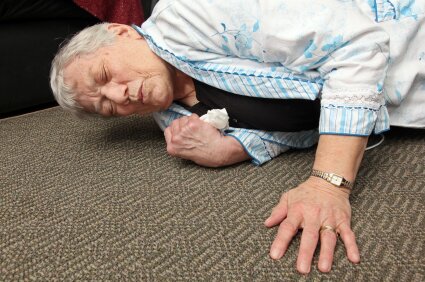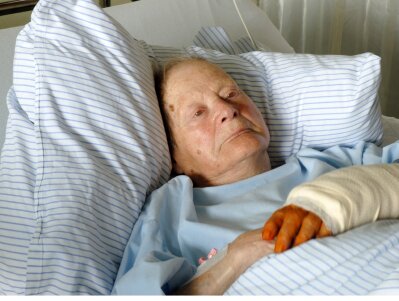Managing a Fall Victim as a CNA
How should I manage a fall victim as a CNA?

Great question! If you don’t already know, falling is one of the number one causes of traumatic deaths for elderly people.
Elderly people often have poor equilibrium, poor musculature, and very frail bones. This leads to quite a dangerous situation. One of the biggest jobs that we have as CNAs is making sure that our patients do not, under any circumstances, fall.
However, elderly patients do tend to fall. Sometimes, it is just inevitable for them to sooner or later fall down. It happens all the time, even under CNA supervision.
First off, let’s discuss what falling down does to our elderly patients. The bones of elderly patients are oftentimes very frail and brittle. These bones tend to break easily during a fall. It is very common to see extremity fractures, spinal fractures, as well as hip and pelvic fractures.
The first thing we should be aware of is the fact that lots of blood can be lost due to a fracture. Bones carry a large amount of blood within them, not to mention a fractured bone can tear into tissues and muscles very easily. Therefore, as soon as an elderly person does fall, we’re going to consider it an emergency.
The fall itself does not usually kill elderly patients, at least not with patients under supervision. It can, however, be very dangerous for elderly people to fall alone at home and not be able to get help. Usually, what kills elderly people after they have fallen is the time it takes for them to get back on their feet.
 Let’s say an elderly person has fallen down and broken his or her hip. Now, they have to lie in bed for a month while the broken bone mends. During this time, the patient’s muscles quickly begin to atrophy. When these muscles begin wasting away, it is particularly difficult to get them back with physical training. Oftentimes, the patient suffers from these falls in a variety of ways, such as loss of independence, loss of confidence, falling paranoia, and of course, inactivity. At this point, our patient is opening his or herself up to a variety of different illnesses, and possibly a shorter life because of it.
Let’s say an elderly person has fallen down and broken his or her hip. Now, they have to lie in bed for a month while the broken bone mends. During this time, the patient’s muscles quickly begin to atrophy. When these muscles begin wasting away, it is particularly difficult to get them back with physical training. Oftentimes, the patient suffers from these falls in a variety of ways, such as loss of independence, loss of confidence, falling paranoia, and of course, inactivity. At this point, our patient is opening his or herself up to a variety of different illnesses, and possibly a shorter life because of it.
Obviously, the best way to help a patient is to try our best to keep the patient from falling. Prevention is key. We can, of course, help to keep our patients from falling by being attentive and watchful of them while they are walking; making sure they use handrails appropriately, and ensuring the safety and security of our patients as they sleep.
Treatment for Patient Falls
For a patient that has fallen, these are the steps we should take:
![]() If a patient has fallen, it is an emergency. Have another CNA call an ambulance, or if needed, call an ambulance yourself.
If a patient has fallen, it is an emergency. Have another CNA call an ambulance, or if needed, call an ambulance yourself.
![]()
Unless the patient’s airway is compromised, or he or she is for some reason in a dangerous position or environment, DO NOT MOVE the patient. This patient is considered in jeopardy of spinal fracture. In this case, only a doctor will be able to clear them of that possible injury. The paramedics will immediately put the patient in spinal precaution upon arrival.
If you do move the patient, you are putting the patient in risk of furthering his or her back injury, and putting yourself at risk for lawsuits. Be very careful with elderly falls.
![]()
Check the patient for any bleeding, and obvious broken bones. Control any bleeding if possible; a lot of elderly patients are taking blood thinners due to atrial fibrillation, so controlling any bleeding is a priority.
The best way to control bleeding is by putting pressure on the wound with a sterile dressing.
![]() Keep the patient calm, and keep the patient from moving (especially moving his or her head).
Keep the patient calm, and keep the patient from moving (especially moving his or her head).


